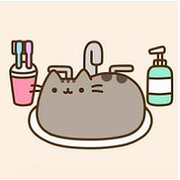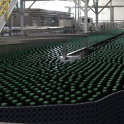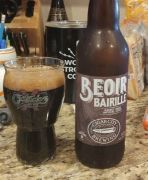Marshmallow Blue posted:RIS, barleywine, bochet, flanders red maybe? The bochet sounds interesting. I might have to make a small batch to try it out. I'm not a fan of barleywines so I'm leaning more to the RIS. I wonder how well a flanders red would age.
|
|
|
|
|

|
| # ? Jun 7, 2024 04:42 |
|
Josh Wow posted:Pretty much any home kegerator needs 10-12' of line if you're running at standard (2.55-2.70) carbonation levels. I just tell people to start with 12' and cut some off if it's pouring too slow. Another good rule of thumb is it should pour at 1 oz per second. OK I'm a little confused because I'm really picky about my carb levels and I've not had any issue with this setup since I cut my tubing back. I'm force carbing my beers beforehand, then setting my regulator to serving pressure. I suppose over time it could go down, but I don't follow you here.
|
|
|
|
robotsinmyhead posted:OK I'm a little confused because I'm really picky about my carb levels and I've not had any issue with this setup since I cut my tubing back. I'm force carbing my beers beforehand, then setting my regulator to serving pressure. I suppose over time it could go down, but I don't follow you here. 2.2 vol CO2 is low for many styles, it's also either spot on, or the high point for a lot of others. If I carbonated my English beers to 2.6vol, I'm pretty sure they'd taste wrong. US and Belgian styles tend to be higher 2.3-2.8, but it really depends on what you're brewing for how you balance. I packaged a Tripel in bottles to 3.4 volumes two years ago and it was amazing. My Standard Bitter gets about 1.9-2.0 depending on my mood. The easy thing is, you can just turn your regulator up or down a little when you need to have a different rate, and turn off your valves in between if you're playing with levels. Just like everything else in brewing, there's not a one-size fits all answer. If you're just buying kegs of US production beer, 2.6 or so is not going to do you terribly, but most people won't even look into the difference. In other news, I seem to always pick the windiest day of the week to brew. This saison will go on, but the boil is going to be a pain.
|
|
|
|
I was more or less commenting on this idea that serving pressure and carbing pressure were entirely linked. If I'm carbing my beers to 2.6ish and serving from a 'balanced line', there shouldn't be any changes to the volume of CO2 in my beer. I am, of course, just using my experience to judge that 2.6 volume - comparing my beers (usually IPAs) with commercially available beers, as well as judging them from bottled beers I've made that I've dosed with priming sugar for a 2.5-2.7 range. Obviously slow-carbing a beer from flat to serving pressure without adjusting the regulator would be a different story.
|
|
|
|
Jhet posted:Looks like a normal barb inside the tubing that you have on there. Just cut the tubing off and use a worm clamp to replace as it only takes a screwdriver to tighten. It won't look as nice, but it will work just as well and you'll be able to replace the lines when they start getting gross. Yeah, I've got a couple spare worm clamps laying around. I was more concerned with how to remove the existing tubing from that crimping, since it seems attached to the wingnut assembly. Do I just yank the tube out then try to jam my new line in there, then use the worm clamp over it?
|
|
|
|
calandryll posted:So my wife and I are looking to have a child in the near future. I got to thinking about brewing something that I could bottle and open once a year on their birthday. I was thinking of something like a Russian imperial stout. Has anyone attempted something crazy/stupid like this? What got me thinking about this was Mike Tonsmeire recent post.
|
|
|
|
To keep the whole beer line/keezer chat going: how do you guys clean beer lines? I cant seem to think of any easy way to do this without either buying or building some kind pump arrangement that recirculates line cleaner through them or disassembling them constantly.
|
|
|
|
calandryll posted:Ok I must be a weirdo or something because I keep my keezer around 47F or so. This guy right here did it. My wife and I had our little girl in May 2017. We are looking at opening the first of 21 bottles in May. Brewed a Bigfoot clone, called it "Little Feet" and used the image of her footprints from the birth as part of the bottle label. Fatherhood Protip: Brew a LOOOOOOOOOOOOOOOOOOOOOOOOOOT of beer before the baby comes. After that it's going to take you some time to get back into brewing. You'll want to make sure you are fully stocked. LaserWash fucked around with this message at 18:40 on Jan 31, 2018 |
|
|
|
Mead can be enjoyed in small quantities and will get better for decades. I wish I still had some of my first batch, it was only about three years old last year when I had the last bottle, but it was so good after all that time. A RIS would be really good but I've never had one older than 10 years, do they really hold up with carbonation for decades? I brewed one a few months ago and I was only planning on saving some until next new year's, but I might pick one or two pints and hide them.
|
|
|
|
^^ I didn't start brewing until after the kid was born. He was about a year old when I started and is now 4. Weather and moving has more to do with me not brewing, but the hardest stage to actually do it was while he was 2-3. After that he was less clumsy and would actually help. Now he's in pre-school and my whole stay at home to take care of him thing has a big break in the day which is just enough time to complete any standard brew sessions.Henrik Zetterberg posted:Yeah, I've got a couple spare worm clamps laying around. I was more concerned with how to remove the existing tubing from that crimping, since it seems attached to the wingnut assembly. Do I just yank the tube out then try to jam my new line in there, then use the worm clamp over it? You should be able to just cut it out with a utility knife or tube cutter and not even worry about the part that's inside that crimp. From the picture it doesn't look like it's actually necessary except for aesthetics. If you can wiggle it in after pulling it out, more power to you, but just tighten the new line down with a worm clamp on that existing barb.
|
|
|
|
Mr. Clark2 posted:To keep the whole beer line/keezer chat going: how do you guys clean beer lines? I cant seem to think of any easy way to do this without either buying or building some kind pump arrangement that recirculates line cleaner through them or disassembling them constantly.
|
|
|
|
Mr. Clark2 posted:To keep the whole beer line/keezer chat going: how do you guys clean beer lines? I cant seem to think of any easy way to do this without either buying or building some kind pump arrangement that recirculates line cleaner through them or disassembling them constantly. Total replacement of my beer service lines is ~4ft of tubing and about 20min of work, so I just change them all out about twice a year. While I'm doing that, I usually remove the taps and soak them as well. Once in a while while cleaning a keg, I'll pressurize some cleaning/sanitizing fluid in the keg and run it through the lines as well cause that only takes a minute, but that's mostly to degunk the faucets if they're sticky.
|
|
|
|
Jhet posted:^^ I didn't start brewing until after the kid was born. He was about a year old when I started and is now 4. Weather and moving has more to do with me not brewing, but the hardest stage to actually do it was while he was 2-3. After that he was less clumsy and would actually help. Now he's in pre-school and my whole stay at home to take care of him thing has a big break in the day which is just enough time to complete any standard brew sessions. My boy is 4 now and insists on helping clean bottles which can be hair raising. His other areas of brewing expertise include smelling the bowls of hops before I put them in the boil, and explaining to me how yeast works.
|
|
|
|
Skellyscribe posted:My boy is 4 now and insists on helping clean bottles which can be hair raising. His other areas of brewing expertise include smelling the bowls of hops before I put them in the boil, and explaining to me how yeast works. Has he seen Alton Brown's burping yeast explanations?
|
|
|
|
Pham Nuwen posted:Has he seen Alton Brown's burping yeast explanations? I'll have to check that out. His basic understanding is the yeast are "friends" that live in the beer, which is also the extent of my knowledge on the subject.
|
|
|
|
Jhet posted:You should be able to just cut it out with a utility knife or tube cutter and not even worry about the part that's inside that crimp. From the picture it doesn't look like it's actually necessary except for aesthetics. If you can wiggle it in after pulling it out, more power to you, but just tighten the new line down with a worm clamp on that existing barb. Oh I see what you're saying. If I was at home, I'd get a better picture, but I don't think the barb sticks out past the metal crimping, unfortunately. e: I may have to snip it off somehow to expose the barb. e2: I guess I can just check out my local homebrew place to see if they have any 90 degree tailpiece barbs. Henrik Zetterberg fucked around with this message at 21:51 on Jan 31, 2018 |
|
|
|
robotsinmyhead posted:I was more or less commenting on this idea that serving pressure and carbing pressure were entirely linked. If I'm carbing my beers to 2.6ish and serving from a 'balanced line', there shouldn't be any changes to the volume of CO2 in my beer. Peep this chart: http://www.zahmnagel.com/wp-content/uploads/2017/04/Zahm-Nagel-CO2-in-Beer-Chart.pdf It shows the correllation between pressure and temperature. Long story short if you look at the intersection of the temperature and head pressure of your keg it'll show you what CO2 level your beer will end up at. You might carb your keg to 2.6 vol but if you set your head pressure and temperature to what you were saying after a day or two it will come to equilibrium at 2.2. The co2 comes out of the beer and goes into the headspace of the keg. I'm sure I explained that terribly but I just got done working 13 hours. If you have any questions that would let me clarify things better I'd be happy to answer them.
|
|
|
|
Syrinxx posted:There are kits online or at the LHBS for line cleaning, they usually involve a bottle with a hose to attach to the shank and they work by either gravity or a little hand pump. Just put the cleaner though the line from tower down to your keg connector which is disassembled or in a bowl or something, repeat, done. I push about a gallon of oxyclean and starsan through my lines with CO2 after every keg kicks. I'm already using them go clean out the kicked keg so I might as well empty the keg of those through my lines to clean those too. I open and close the faucet a lot during this time to work cleaner into the valve a bit and give it a quick brush as I do that.
|
|
|
|
Josh Wow posted:Peep this chart: That timeline hasn't been my experience, but if I leave my taps on for long time, I have noticed some degradation over much longer periods (1 week+) in carbonation. I'm actually pretty partial to disconnecting my gas lines when I'm not drinking because most of my unexpected gas loss seems to come from the loose-fitting nature of pin/ball lock connections. Reconnecting them is literally just lifting the lid and snapping them in place so I think it's a pretty good method for me. That said, I'll probably re-balance things for 12psi. robotsinmyhead fucked around with this message at 03:34 on Feb 1, 2018 |
|
|
|
Skellyscribe posted:I'll have to check that out. His basic understanding is the yeast are "friends" that live in the beer, which is also the extent of my knowledge on the subject. AB's explanation is awesome. It involves sock puppets. https://www.youtube.com/watch?v=FqxkMqsEQI0 I managed to overshoot my efficiency by almost 10pts yesterday. I was aiming for 1.044 and hit 1.053. It's a little absurd and I'm not sure I could repeat it if I tried.
|
|
|
|
Jhet posted:AB's explanation is awesome. It involves sock puppets. https://www.youtube.com/watch?v=FqxkMqsEQI0 I did that, then undershot by 20 the next brew day (expecting I could repeat results so really -10). what the crap?! Normally just happy with my 65% on the regular.
|
|
|
|
Marshmallow Blue posted:I did that, then undershot by 20 the next brew day (expecting I could repeat results so really -10). what the crap?! Yeah, not sure how I managed it, my average mash temp over 75 minutes was maybe 1 degree below my target. I won't be changing anything about my process or recipe creation because I'd rather have too good of a day than a really terrible one.
|
|
|
|
I think part of it was that it was the aforementioned baltic porter, so the grain bill was a bit much for my system.
|
|
|
|
Leftover Pellicle Porn It's surprising and kinda concerning that souring bacteria can survive a 20min boil. This is racking from primary -> keg. Kettle soured in the keg under a CO2 blanket.
|
|
|
|
robotsinmyhead posted:Leftover Pellicle Porn It really can't. You probably carried it over into the bucket from a piece of equipment that didn't get sanitized/sterilized by fire. I had this issue in a 1g jug I reused from having made eggnog in it. I didn't do a good enough job killing the bacteria with heat/caustic and ended up with acid in the experiment. Turned out fine, but I knew it was below par sanitation that screwed it up.
|
|
|
|
Jhet posted:It really can't. You probably carried it over into the bucket from a piece of equipment that didn't get sanitized/sterilized by fire. I had this issue in a 1g jug I reused from having made eggnog in it. I didn't do a good enough job killing the bacteria with heat/caustic and ended up with acid in the experiment. Turned out fine, but I knew it was below par sanitation that screwed it up. I suppose that's true, but I've done this 5-6 times now and I've always had a recurrent pellicle in the primary.
|
|
|
|
robotsinmyhead posted:I suppose that's true, but I've done this 5-6 times now and I've always had a recurrent pellicle in the primary. Are you sure they're not just yeast rafts? You could check if you had a microscope that does at least x1000. Best to take a sample directly after the boil and then another after primary is complete to check for differences. I imagine at this point you're not using that bucket for anything else either? Could just be hiding in the cracks at this point too.
|
|
|
|
Jhet posted:Are you sure they're not just yeast rafts? You could check if you had a microscope that does at least x1000. Best to take a sample directly after the boil and then another after primary is complete to check for differences. That's my designated "Bug Bucket", so that's the most likely scenario. It's definitely a pellicle though. It's not really causing a problem, just a curiosity.
|
|
|
|
robotsinmyhead posted:That's my designated "Bug Bucket", so that's the most likely scenario. It's definitely a pellicle though. It's not really causing a problem, just a curiosity. It's in the bucket.
|
|
|
|
Iím brewing a 5 gallon all-grain BIAB brown Porter later this week that I plan on putting .75 lbs of Demerara sugar in to. Iíve heard of people waiting and adding sugars after a couple days of fermentation for the yeastís sake but for that quantity would that be necessary? It seems like just one more shot at something going wrong to open it up during primary. My thought unless thereís a good reason not to is to add it after pulling the grain bag out and before relighting the burner, because the wort will be hot enough for it to dissolve well but shouldnít have any chance of scorching as long as I stir it really well before relighting.
|
|
|
|
Fork of Unknown Origins posted:Iím brewing a 5 gallon all-grain BIAB brown Porter later this week that I plan on putting .75 lbs of Demerara sugar in to. Iíve heard of people waiting and adding sugars after a couple days of fermentation for the yeastís sake but for that quantity would that be necessary? It seems like just one more shot at something going wrong to open it up during primary. I pretty much always add a pound of Demerara to my Trappist style beers at flameout, has always turned out good
|
|
|
|
I like to add sugars in the last ten or fifteen minutes of the boil. You can pause the clock, turn off the fire, and stir in the sugar until dissolved, the relight, if you're worried. But the important bit is making sure you get what you want out of the beer. If you're not going super hoppy, adding the sugar late is not a huge deal, so add it (and dissolve it) early.
|
|
|
|
I'm back, my first mead appears to be a success. It's been about 4 weeks and it hasn't been bubbling for probably 2-3 weeks. I took a sample last night and it tastes fantastic, crystal clear too. I'm ready to bottle, since I only made ~1 gallon I'm thinking of using 16 oz swing top bottles. I'd like to experiment with carbonating half of them. Should I wait longer to bottle to be %100 sure it's done fermenting? To me it appears like it's done but I know that can be decieving. Anything special for carbonating Mead? I was just gonna throw a bit of priming sugar into the bottles I want carbonated.
|
|
|
|
|
Popete posted:I'm back, my first mead appears to be a success. It's been about 4 weeks and it hasn't been bubbling for probably 2-3 weeks. I took a sample last night and it tastes fantastic, crystal clear too. If you arenít able to check your gravity, itís hard to tell except by practice and taste. It certainly should be close, but mead is an interesting one because it really needs nutrients and time. If it tastes as dry as you expect then you may as well bottle. Swing tops are fine, and if youíre not carbing all of them, itíll give you a way to know if it was actually done fermenting in a couple weeks. Priming sugar mixed with water and then I do it by weight per bottle.
|
|
|
|
Also it should be crystal clear before bottling or you'll get a lot of sediment in bottles.
|
|
|
|
So would a relatively light chocolate milk stout stand up well to bourbon oak spirals or bourbon soaked cocoa nibs and coffee in the secondary or should I save my oak spirals for a bigger beer? This is a kit recipe and it calls for throwing a few oz of baking chocolate into the boil as well, not sure how the oils in that will mess with carbonation. I intend to do cocoa nibs in the secondary regardless of whether I do oak or coffee. I'm leaning towards skipping the bakers chocolate and just using nibs in the secondary, and possibly adding some coffee as well, just not sure how much to add and when. For reference the grain bill is 7 lbs US 2-row 1 lb Chocolate malt 1 lb Crystal 40 8oz each of flaked wheat and roasted malt. 1lb lactose.
|
|
|
|
Popete posted:I'm back, my first mead appears to be a success. It's been about 4 weeks and it hasn't been bubbling for probably 2-3 weeks. I took a sample last night and it tastes fantastic, crystal clear too. What recipe did you make? I've got 3 gallons of plain honey mead that I started in September and it's still completely cloudy, on the other hand the 1 gallon batch of JAOM I made a couple months back is getting pretty clear (it's a beautiful golden color and *pretty* clear but I've seen it start to get even clearer at the very top so I'm still waiting).
|
|
|
|
Jhet posted:kegerator advice Got my lines swapped over the weekend, so thank you for your help. Removing the nut behind the faucet was a pain in the rear end. I didn't want to buy a $40 wrench, so I made my own out of a 1 1/16 wrench I had with a Dremel. Kind of clunky because it's so thick, but I got it working. Kegs both pour great now with 10-foot lines!
|
|
|
|
Pham Nuwen posted:What recipe did you make? I've got 3 gallons of plain honey mead that I started in September and it's still completely cloudy, on the other hand the 1 gallon batch of JAOM I made a couple months back is getting pretty clear (it's a beautiful golden color and *pretty* clear but I've seen it start to get even clearer at the very top so I'm still waiting). Do you happen to have a temperature read on the room your mead is sitting in? My first batch (15 pounds of honey, 4.5 gallons of water, EC-1118) sat at 68 degrees constantly, and totally cleared one or two months after the second racking. Maybe a temperature thing? The price of the Buon Minijet wine filter dropped unexpectedly so I picked one up. I have some mead that's about 3 weeks into its primary, so it will be quite a while before I have a chance to use it, but I'll report back once I get a chance to use it. Kind of excited for new toys to put into the fermentation hobby. Bubbling has slowed, I'll check SG this weekend and see if it's stalling or it's near enough that I can rack to secondary.
|
|
|
|

|
| # ? Jun 7, 2024 04:42 |
|
Apache posted:So would a relatively light chocolate milk stout stand up well to bourbon oak spirals or bourbon soaked cocoa nibs and coffee in the secondary or should I save my oak spirals for a bigger beer? This is a kit recipe and it calls for throwing a few oz of baking chocolate into the boil as well, not sure how the oils in that will mess with carbonation. I intend to do cocoa nibs in the secondary regardless of whether I do oak or coffee. I'm leaning towards skipping the bakers chocolate and just using nibs in the secondary, and possibly adding some coffee as well, just not sure how much to add and when. Bourbon, milk, chocolate, coffee stout sounds really busy to me. Not that it canít work, but thereís a lot of balancing involved. If youíre going with a kit, Iíd probably not add too many extra things. Iíd probably pick either the coffee or the chocolate and just go with one extra facet precisely because itís a lighter stout. Oils wonít mess with carbonation, but it can lessen your head retention. It wonít be as bad as adding peanut butter, it just wonít stick around forever.
|
|
|


























